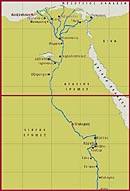The main concern of the Ptolemies was the prevention of exterior attacks against Egypt and this is the reason why many scholars agree that almost every war conducted against the Seleucids was mostly defensive. Their effort to control Coele ('Hollow') Syria and Cyprus derived from their concern to minimize some potential raids from the north and northeast borders of their state. At the same time, the clear anti-Macedonian orientation of their foreign policy is reflected in their effort to control the Aegean sea, in order to counterbalance both the Antigonids' influence in Greece and their expansion in Asia Minor.
The Macedonians and other Greeks were the ruling class, as in the other Hellenistic kingdoms. However, the Ptolemies did not encourage the founding of cities, with the only exception being that of Ptolemais in Upper Egypt, the only city founded by Ptolemy I. The strong centralized character of the Pharaonic state, which was adopted by the Ptolemies, totally opposed the institution of the cities, even if they ceded limited autonomy to them. However, Alexandria, perhaps the most cosmopolitan intellectual centre of the Hellenistic world, is distinguished in the Egyptian kingdom as being a place where a heterogenous population existed comprising Macedonians, other Greeks, Hebrews and Egyptians.
From the end of the
| introduction | Alexander | successors | kingdoms | Greece | freedom |
Note: Click on the small photo to enlarge it.

01. Map depicting Egypt during the reign of the Ptolemies. Only Alexandria, Naucratis and Ptolemais were Greek cities, organised

02. Alexandria was developed into a powerful economic and cultural centre of the Hellenistic world. The picture shows an hypothetical representation of the city, as seen from the south, between lake Mareotida and the islet of Pharo. Watercolour by